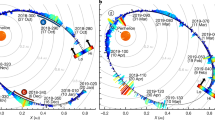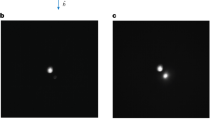Abstract
PERHAPS the most unexpected finding of the Ulysses mission so far has been the detection of quasi-periodic streams of high-velocity, submicrometre-sized dust particles during the spacecraft's encounter with Jupiter1. The impact geometry clearly shows that these small grains originate in the jovian system, but it is surprising that any dust can escape Jupiter's gravitational influence. Here we show how the Ulysses dust events could result from the acceleration and subsequent ejection of small grains by Jupiter's magnetosphere. Dust grains entering the plasma environment of the magnetosphere become charged, with the result that their motion is then determined by both electromagnetic and gravitational forces. We have modelled this process and find that only those particles in a certain size range gain sufficient energy to escape the jovian system. Moreover, if Io is assumed to be the source of the dust grains, its location in geographic and geomagnetic coordinates determines the exit direction of the escaping particles, providing a possible explanation for the observed periodicities. The calculated mass and velocity ranges of the escaping dust grains are consistent with the Ulysses findings.
This is a preview of subscription content, access via your institution
Access options
Subscribe to this journal
Receive 51 print issues and online access
$199.00 per year
only $3.90 per issue
Buy this article
- Purchase on Springer Link
- Instant access to full article PDF
Prices may be subject to local taxes which are calculated during checkout
Similar content being viewed by others
References
Grün, E. et al. Nature 362, 428–430 (1993).
Johnson, T. V., Morfill, G. & Grün, E. Geophys. Res. Lett. 7, 305–308 (1980).
Morfill, G., Grün, E. & Johnson, T. V. Planet. Space Sci. 28, 1087–1100 (1980).
Bagenal, F. in Time-Variable Phenomena in the Jovian System (ed. Belton, M.) 196–210 (NASA-SP 494, 1989).
Connerney, J. E. P., Acun̄a, M. H. & Ness, N. F. J. geophys. Res. 86, 8370–8384 (1981).
Author information
Authors and Affiliations
Rights and permissions
About this article
Cite this article
Horanyi, M., Morfill, G. & Grün, E. Mechanism for the acceleration and ejection of dust grains from Jupiter's magnetosphere. Nature 363, 144–146 (1993). https://doi.org/10.1038/363144a0
Received:
Accepted:
Issue Date:
DOI: https://doi.org/10.1038/363144a0
This article is cited by
-
Modulational Instability of Dust Acoustic Waves in an Opposite Polarity Dusty Plasma in the Presence of Generalized Polarization Force with Superthermal Electrons and Ions
Brazilian Journal of Physics (2021)
-
Dust in the Jupiter system outside the rings
Astrodynamics (2019)
-
Circumplanetary Dust Populations
Space Science Reviews (2019)
-
Dust Emission by Active Moons
Space Science Reviews (2018)
-
Fast and Slow Mode Solitary Waves in a Five-Component Plasma
Brazilian Journal of Physics (2017)
Comments
By submitting a comment you agree to abide by our Terms and Community Guidelines. If you find something abusive or that does not comply with our terms or guidelines please flag it as inappropriate.



